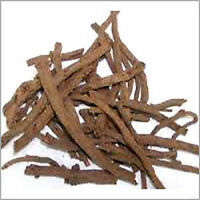
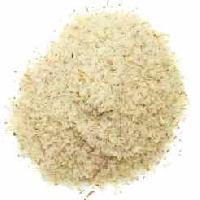
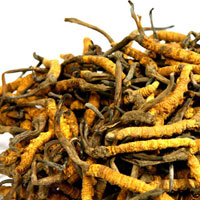
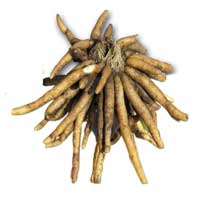

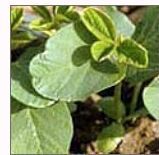
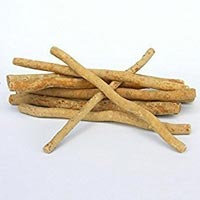
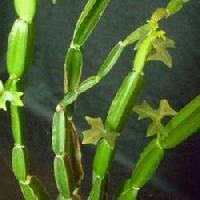
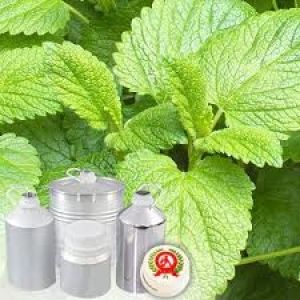
Angelica
Get Price Quote
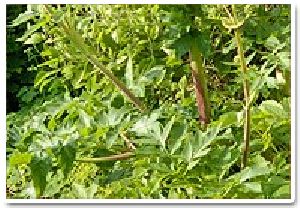
Angelica
Get Price Quote
It is any of the various herbs of the genus Angelica in the parsley/Apiaceae family. These herbs usually have feather like compound leaves and small white or greenish flowers in flat-topped or rounded flower cluster. The stems are sweet in taste. The roots and fruits are used for flavoring liqueurs. It is native to temperate and subarctic regions of the Northern Hemisphere, reaching as far North as Iceland and Lapland. Angelica is used extensively in both Western healing and traditional Chinese medicine. Usually the dried root is used medicinally. The pale green, celery like stalks are most often candied and used as decorations for cakes and other desserts. Etymological Background The name angelica apparently has been derived from a story of an angel who appeared to a monk in a dream and revealed to him that a plant would cure the plague. The herb has since then been known as Angelica. Angelica is sometimes known by the nickname of ‘Root of the Holy Ghost’. Its is so called because angelica was thought to be under the protection of Michael the Archangel as it blooms on his feast day, May 8th according to the old Julian Calendar. While according to others this holy name is due to its seeming ability to cure anything and everything. For both reasons, it was considered to be a great defense against evil spirits, witches, spells and even the plague. Species There are a wide variety of species of angelica are known to us, some of the most commonly known species include the following:- Angelica ampla – Giant Angelica Angelica archangelica – Garden Angelica, Archangel, Angelique Angelica arguta – Lyall’s Angelica Angelica atropurpurea – Purplestem Angelica, Alexanders Angelica breweri – Brewer’s Angelica Angelica californica – California Angelica Angelica callii – Call’s Angelica Angelica canbyi – Canby’s Angelica Angelica cartilaginomarginata Angelica dahurica – bai zhi in Chinese Angelica dawsonii – Dawson’s Angelica Angelica dentata – Coastalplain Angelica Angelica genuflexa – Kneeling Angelica Angelica gigas – Cham dangwi in Korean Angelica glabra – synonym for Angelica dahurica Angelica scabrida – Charleston Mountain Angelica Angelica wheeleri – Utah Angelica. Angelica venosa – Hairy Angelica Historical Background Owing to the various legends surrounding this herb, it was believed to ward off evil spirits and witches. Its juices were drunk to avert spells and poisons. Angelica has been used for centuries in European medicine as an expectorant for bronchial illnesses, colds and coughs and also as a digestive aid for stomach disorders. By the fifteenth century it was commonly used. In the English herbal treatise called Paradisus Terrestris, published in 1629 C.E. by John Parkinson, angelica is regraded to be one of the most important medicinal herbs of that time. Medicinal Uses The root stalks, leaves and fruit possess carminative, stimulant, diaphoretic, stomachic, tonic and expectorant properties, which are strongest in the fruit, though the whole plant has the same virtues. Angelica is a good remedy for colds, coughs, pleurisy, wind, colic, rheumatism and diseases of the urinary organs, though it should not be given to patients who have a tendency towards diabetes, as it causes an increase of sugar in the urine. It is generally used as a stimulating expectorant, combined with other expectorants the action of which is facilitated, and to a large extent diffused, through the whole of the pulmonary region. It is a useful agent for feverish conditions, acting as a diaphoretic. An infusion may be made by pouring a pint of boiling water on an ounce of the bruised root, and two table spoonsful of this should be given three or four times a day, or the powdered root administered in doses of 1O to 30 grains. The infusion will relieve flatulence, and is also of use as a stimulating bronchial tonic, and as an emmenagogue. It is used much on the Continent for indigestion, general debility and chronic bronchitis. For external use, the fresh leaves of the plant are crushed and applied as poultices in lung and chest diseases.
Best Deals from Chinese Angelica
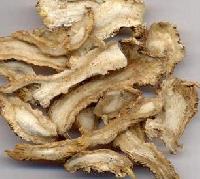
Chinese angelica
Get Price Quote
Chinese angelica, Herbal Extracts, aromatic oils, Medicinal Plants

Angelica
Get Price Quote
Angelica, Vegetable Oils, Rose Oil RUH, Cumin Seed Oil